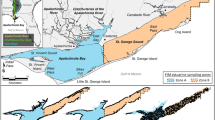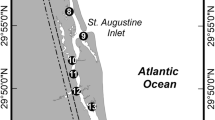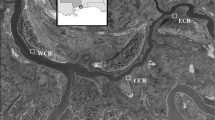Abstract
Natural patterns of freshwater delivery to the Florida Bay estuary have been disrupted by flood-control and water-supply projects. Restoration efforts are likely to alter salinity regimes and patterns of nekton distribution and abundance. Spatial and seasonal community structure differences were analyzed for small-bodied and large-bodied nekton collected by fisheries-independent monitoring from 2006 through 2009 in the northeastern basins of Florida Bay. The small-bodied nekton community was dominated by resident fish that may be indicators of ecosystem health because they spend their lives within the bay and are not directly influenced by human harvest; the large-bodied nekton community was dominated by transient and, in some cases, economically important species. Differences in community structure revealed a gradient in similarity that was associated with freshwater influence, as determined by salinity variability over the study period. These observed changes associated with salinity regimes within and between basins underscore the importance of monitoring communities before and after alterations in freshwater inflow.




Similar content being viewed by others
References
Bell, J.D., A.S. Steffe, and M. Westoby. 1988. Location of seagrass beds in estuaries: Effects on associated fish and decapods. Journal of Marine Biology and Ecology 122(2): 127–146.
Bray, J.R., and J.T. Curtis. 1957. An ordination of the upland forest communities of southern Wisconsin. Ecological Monographs 27: 325–349.
Browder, J.A. 1985. Relationship between pink shrimp production on the Tortugas grounds and water flow patterns in the Florida Everglades. Bulletin of Marine Science 37: 839–856.
Burd, A.B., and G.A. Jackson. 2002. An analysis of water column distributions in Florida Bay. Estuaries 25(4A): 570–585.
Chester, A.J., and G.W. Thayer. 1990. Distribution of spotted seatrout (Cynoscion nebulosus) and gray snapper (Lutjanus griseus) juveniles in seagrass habitats of western Florida Bay. Bulletin of Marine Science 46(2): 345–357.
Clarke, K.R. 1993. Non-parametric multivariate analyses of changes in community structure. Australian Journal of Ecology 18: 117–143.
Clarke, K.R., and M. Ainsworth. 1993. A method of linking multivariate community structure to environmental variables. Marine Ecology Progress Series 92: 205–219.
Clarke, K.R., and R.N. Gorley. 2006. PRIMER v6: User manual/tutorial. Plymouth: PRIMER-E.
Clarke, K.R., and R.M. Warwick. 2001. Change in marine communities: An approach to statistical analysis and interpretation, 2nd ed. Plymouth: Natural Environment Research Council, Plymouth Marine Laboratory.
Collins, M.R. 1985. Species profiles: Life histories and environmental requirements of coastal fishes and invertebrates (south Florida)—White mullet. United States Fish and Wildlife Service, Biological Report 82(11.39).
Cosby, B.J., W.K. Nuttle, and J.W. Fourqurean. 1999. FATHOM: Model description and initial application to Florida Bay. Progress completion report. National Park Service, US Department of Interior, Washington, DC.
Eleuterius, L.N. 1987. Seagrass ecology along the coasts of Alabama, Louisiana, and Mississippi. Florida Marine Research Publications 42: 11–24.
Evans, D.W., and P.H. Crumley. 2005. Mercury in Florida Bay fish: Spatial distribution of elevated concentrations and possible linkages to Everglades restoration. Bulletin of Marine Science 77(3): 321–345.
Fedler, A.J. 2009. The economic impact of recreational fishing in the Everglades region. Report to the Everglades Foundation. Key Largo: Bonefish and Tarpon Trust.
Field, J.G., K.R. Clarke, and R.M. Warwick. 1982. A practical strategy for analysing multispecies distribution patterns. Marine Ecology Progress Series 8: 37–52.
Flaherty, K.E., R.E. Matheson Jr., F.X. Courtney, and R.F. Jones. 2010. Nekton communities associated with seagrass in Tampa Bay: The effects of seagrass bed architecture, seagrass species composition, and varying degrees of freshwater influence. In Proceedings of the Tampa Bay Area Scientific Information Symposium, BASIS 5, 20–23 October 2009, St. Petersburg, FL, ed. S.T. Cooper, 275–298.
Flores-Verdugo, F., F. González-Farías, O. Ramírez-Flores, F. Amezcua-Linares, A. Yáñez-Arancibia, M. Alvarez-Rubio, and J.W. Day Jr. 1990. Mangrove ecology, aquatic primary productivity, and fish community dynamics in the Teacapán–Agua Brava Lagoon–Estuarine System (Mexican Pacific). Estuaries 13(2): 219–230.
Forcucci, D., M.J. Butler IV, and J.H. Hunt. 1994. Population dynamics of juvenile Caribbean spiny lobster, Panulirus argus, in Florida Bay, Florida. Bulletin of Marine Science 54: 805–818.
Gilbert, C.R. (ed.). 1992. Rare and endangered biota of Florida. Volume 2. Fishes. University Press of Florida, Gainesville. 247 p.
Herbert, D.A., W.B. Perry, B.J. Cosby, and J.W. Fourqurean. 2011. Projected reorganization of Florida Bay seagrass communities in response to the increased freshwater inflow of Everglades restoration. Estuaries and Coasts 34(5): 973–992.
Herrnkind, W.F., and M.J. Butler IV. 1994. Settlement of spiny lobster, Panulirus argus (Latreille, 1804), in Florida: Pattern without predictability? Crustaceana 67: 46–64.
Hittle, C., E. Patino, and M. Zucker. 2001. Freshwater flow from estuarine creeks into northeastern Florida Bay. Water Resources Investigations Reports 01-4164, US Geological Survey, Tallahassee, FL.
Kelble, C.R., E.M. Johns, W.K. Nuttle, T.N. Lee, R.H. Smith, and P.B. Ortner. 2007. Salinity patterns of Florida Bay. Estuarine, Coastal and Shelf Science 71: 318–334.
Lee, T.N., E. Johns, D. Wilson, E. Williams, and N. Smith. 2002. Transport processes linking south Florida coastal ecosystems. In The Everglades, Florida Bay, and coral reefs of the Florida Keys: An ecosystem source book, ed. J.W. Porter and K.G. Porter, 309–342. Boca Raton: CRC.
Lee, T.N., E. Johns, N. Melo, R.H. Smith, P. Ortner, and D. Smith. 2006. On Florida Bay hypersalinity and water exchange. Bulletin of Marine Science 79: 301–327.
Lee, T.N., N. Melo, E. Johns, C. Kelble, R.H. Smith, and P. Ortner. 2008. On water renewal and salinity variability in northeastern Florida Bay. Bulletin of Marine Science 82(1): 83–105.
Ley, J.A., C.C. McIvor, and C.L. Montague. 1999. Fishes in mangrove prop-root habitats of northeastern Florida Bay: Distinct assemblages across an estuarine gradient. Estuarine, Coastal and Shelf Science 48(6): 701–723.
Lorenz, J.J. 1999. The response of fishes to physiochemical changes in the mangroves of northeast Florida Bay. Estuaries 22(2B): 500–517.
Matheson, R.E., Jr. 1983. Taxonomic studies of the Eucinostomus argenteus complex (Pisces: Gerreidae). Ph.D. dissetation, Texas A&M University, College Station.
Matheson Jr., R.E., D.K. Camp, S.M. Sogard, and K.A. Bjorgo. 1999. Changes in seagrass-associated fish and crustacean communities on Florida Bay mud banks: The effects of recent ecosystem changes? Estuaries 22(2B): 534–551.
McMichael, R.H. Jr. 2010. Fisheries-Independent Monitoring Program 2009 annual data summary report. Fish and Wildlife Research Institute, Florida Fish and Wildlife Conservation Commission, In-house Report, IHR-2010-001, St. Petersburg, FL.
Montague, C.L., and J.A. Ley. 1993. A possible effect of salinity fluctuation on abundance of benthic vegetation and associated fauna in northeastern Florida Bay. Estuaries 16: 703–717.
Nuttle, W.K., J.W. Fourqurean, B.J. Cosby, J.C. Zieman, and M.B. Robblee. 2000. The influence of net freshwater supply on salinity in Florida Bay. Water Resources Research 36: 1805–1822.
Pattillo, M.E., Czapla, T.E., Nelson, D.M., and Monaco, M.E. 1997. Distribution and abundance of fishes and invertebrates in Gulf of Mexico estuaries. Volume II. Species life history summaries. ELMR Report 11.
Perry, W. 2004. Elements of south Florida’s Comprehensive Everglades Restoration Plan. Ecotoxicology 13: 185–194.
Peterson, M.S., and S.T. Ross. 1991. Dynamics of littoral fishes and decapods along a coastal river–estuarine gradient. Estuarine, Coastal, and Shelf Science 33: 467–483.
Poulakis, G.R., D.A. Blewett, and M.E. Mitchell. 2003. The effects of season and proximity to fringing mangroves on seagrass-associated fish communities in Charlotte Harbor, Florida. Gulf of Mexico Science 21(2): 171–184.
Powell, A.B. 2003. Larval abundance, distribution, and spawning habits of spotted seatrout (Cynoscion nebulosus) in Florida Bay, Everglades National Park, Florida. Fishery Bulletin 101(3): 704–711.
Powell, A.B., M.W. Lacroix and R.T. Cheshire. 2002. An evaluation of northern Florida Bay as a nursery area for red drum, Sciaenops ocellatus, and other juvenile and small resident fishes. NOAA Technical Memorandum NMFS-SEFSC-485. US Department of Commerce, National Oceanic and Atmospheric Administration, National Ocean Survey, Beaufort, NC.
Powell, A.B., R.T. Cheshire, E.H. Laban, J. Colvocoresses, P. O’Donnell, and M. Davidian. 2004. Growth, mortality, and hatchdate distributions of larval and juvenile spotted seatrout (Cynoscion nebulosus) in Florida Bay, Everglades National Park. Fishery Bulletin 102(1): 142–155.
Price, R.M., W.K. Nuttle, B.J. Cosby, and P.K. Swart. 2007. Variation and uncertainty in evaporation from a subtropical estuary: Florida Bay. Estuaries and Coasts 30(3): 497–506.
Robblee, M.B., T.R. Barber, P.R. Carlson Jr., M.J. Durako, J.W. Fourqurean, L.K. Muehlstein, D. Porter, L.A. Yarbro, R.T. Zieman, and J.C. Zieman. 1991. Mass mortality of the tropical seagrass Thalassia testudinum in Florida Bay (USA). Marine Ecology Progress Series 71(3): 297–299.
Rooker, J.R., and G.D. Dennis. 1991. Diel, lunar, and seasonal changes in a mangrove fish assemblage off southwestern Puerto Rico. Bulletin of Marine Science 9: 684–698.
Rudnick, D.T., Z. Chen, D.L. Childers, J.N. Boyer, and T.D. Fontaine III. 1999. Phosphorus and nitrogen inputs to Florida Bay: The importance of the Everglades watershed. Estuaries 22(2): 398–416.
Rudnick, D.T., P.B. Ortner, J.A. Browder, and S.M. Davis. 2005. A conceptual ecological model of Florida Bay. Wetlands 25(4): 870–883.
SAS Institute Inc. 2006. Base SAS® 9.1.3 procedures guide, 2nd ed., volumes 1–4. SAS Institute Inc., Cary, NC.
Schmidt, T.W. 1979. Ecological study of fishes and water quality characteristics of Florida Bay, Everglades National Park. Final Report N-36. Everglades National Park, Homestead, FL.
Schofield, P.J. 2004. Influence of salinity, competition and food supply on the growth of Gobiosoma robustum and Microgobius gulosus from Florida Bay, U.S.A. Journal of Fish Biology 64: 820–832.
Schomer, N.S., and R.D. Drew. 1982. An ecological characterization of the lower Everglades, Florida Bay, and the Florida Keys. US Fish and Wildlife Service, Office of Biological Services, Washington, DC, FWS/OBS-82/58.1. 246 pp.
South Florida Natural Resources Center (SFNRC). 2011. DataForEVER dataset. Homestead: Everglades National Park.
Sogard, S.M., G.V.N. Powell, and J.G. Holmquist. 1987. Epibenthic fish communities on Florida Bay banks: Relations with physical parameters and seagrass cover. Marine Ecology Progress Series 40: 25–39.
Sogard, S.M., G.V.N. Powell, and J.G. Holmquist. 1989. Utilization by fishes of shallow, seagrass-covered banks in Florida Bay: 1. Species composition and spatial heterogeneity. Environmental Biology of Fishes 24(1): 53–65.
Thayer, G.W., and A.J. Chester. 1989. Distribution and abundance of fishes among basin and channel habitats in Florida Bay. Bulletin of Marine Science 44(1): 200–219.
Thayer, G.W., D.R. Colby, and W.F. Hettler. 1987. Utilization of the red mangrove prop root habitat by fishes in south Florida. Marine Ecology Progress Series 35: 25–38.
Thayer, G.W., A.B. Powell, and D.E. Hoss. 1999. Composition of larval, juvenile, and small adult fishes relative to changes in environmental conditions in Florida Bay. Estuaries 22(2B): 518–533.
Tilmant, J.T. 1989. A history and an overview of recent trends in the fisheries of Florida Bay. Bulletin of Marine Science 44(1): 3–33.
Tolan, J.M., S.A. Holt, and C.P. Enuf. 1997. Distribution and community structure of ichthyoplankton in Laguna Madre seagrass meadows: Potential impact of seagrass species change. Estuaries 20(2): 450–464.
US Army Corps of Engineers (USACE) and South Florida Water Management District (SFWMD). 1999. Central and southern Florida project comprehensive review study: final integrated feasibility report and programmatic environmental impact statement. US Army Corps of Engineers, Jacksonville District and South Florida Water Management District, West Palm Beach, FL. http://www.evergladesplan.org/docs/comp_plan_apr99/summary.pdf.
Vega-Cendejas, M.E., and M. Hernández de Santillana. 2004. Fish community structure and dynamics in a coastal hypersaline lagoon: Rio Lagartos, Yucatan, Mexico. Estuarine, Coastal and Shelf Science 60(2): 285–299.
Weinstein, M.P., S.L. Weiss, and M.F. Walters. 1980. Multiple determinants of community structure in shallow marsh habitats, Cape Fear estuary, North Carolina, USA. Marine Biology 58: 227–243.
Zieman, J.C., J.W. Fourqurean, and R.L. Iverson. 1989. Distribution, abundance and productivity of seagrasses and macroalgae in Florida Bay. Bulletin of Marine Science 44(1): 292–311.
Acknowledgments
We thank all of the biologists and staff of the Fisheries-Independent Monitoring Program at the Fish and Wildlife Research Institute (FWRI) in St. Petersburg, FL, USA for their dedication to sampling and data processing. Special recognition goes to C. Bradshaw, S. Fisk, G. McLaughlin, G. Onorato, B. Pittinger, D. Snodgrass, A. Tyler-Jedlund, and S. Warner of FWRI for leadership during field sampling. Tracy Ziegler (National Park Service) provided logistical support during field sampling. Comments from D. Blewett, G. Onorato, P. Stevens, J. Colvocoresses, B. Crowder, and two anonymous reviewers greatly improved the quality of this manuscript. This project was supported in part by proceeds from State of Florida saltwater recreational fishing licenses and by funding from the US Department of the Interior, National Park Service, study number EVER-00272 and from the US Fish and Wildlife Service, Federal Aid for Sportfish Restoration Project Number F-43. The statements, findings, views, conclusions, and recommendations contained in this document are those of the authors and do not necessarily reflect the views of the US Department of Interior and should not be interpreted as representing the opinions or policies of the US government. Mention of trade names or commercial products does not constitute their endorsement by the US government.
Author information
Authors and Affiliations
Corresponding author
Appendix
Appendix
Rights and permissions
About this article
Cite this article
Flaherty, K.E., Matheson, R.E., McMichael, R.H. et al. The Influence of Freshwater on Nekton Community Structure in Hydrologically Distinct Basins in Northeastern Florida Bay, FL, USA. Estuaries and Coasts 36, 918–939 (2013). https://doi.org/10.1007/s12237-013-9614-3
Received:
Revised:
Accepted:
Published:
Issue Date:
DOI: https://doi.org/10.1007/s12237-013-9614-3




